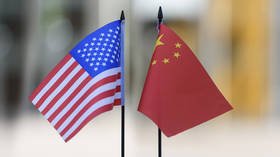As Beijing draws a red line in South China Sea, US shouldn’t expect too much support from its so-called Asian ‘allies’
Tensions are rising between Washington and Beijing over the disputed South China Sea. But with America’s allies unwilling to upset the Chinese, Joe Biden might want to rethink his long-term strategy for the region.
Over four days this week, China is hosting military exercises in the South China Sea. The drills are a response to the United States having sent an aircraft carrier group through the disputed waters, led by the USS Theodore Roosevelt.
This marks a rollover of tensions from the Donald Trump administration to Joe Biden’s, with former Secretary of State Mike Pompeo having declared America’s non-recognition of China’s long-time “nine dash line” maritime boundary.
Today, newly confirmed US Secretary of State Antony Blinken called up his counterpart in the Philippines and stated that the United States stands with its South East Asian allies against China.
There was no expectation that the tensions over the South China Sea would be resolved after the change in administration, even if the rhetoric of Blinken and Biden will not be as unhinged and destabilizing as Pompeo’s. The flashpoint predated Trump, and truly escalated under Barack Obama in response to his “pivot to Asia” policy affirming militarization of the region.
Neither side’s stance is up for debate, and Beijing will continue to set a firm red line and enhance its presence. The mistake the US is making, however, is assuming that its formal allies, such as the Philippines, are interested in pursuing confrontation with China. Instead, they are seeking friendly ties with Beijing, which has shown a shrewd ability to both shift the balance of power and compromise at the same time.
Although China’s claims of control of the South China Sea under the ‘nine dash line’ have been portrayed by the mainstream media as an act of aggression or expansionism, they predate the existence of the state of the People’s Republic of China, which has carried on the policy of its predecessor the Republic of China – which is now contemporary Taiwan, and still formally claims this boundary.
But this isn’t as much a historical argument as it is about the strategic importance of these waters. They contain massive oil reserves, and also constitute one of the busiest shipping routes in the world. China sees maintaining control as essential.
The militarization of the surrounding region by the US under Obama raised the stakes in the South China Sea in both Washington and Beijing. In response to perceived American encirclement, China has consolidated its military presence over the area by constructing artificial islands and expanding its air force reach.
The US argues that China’s maritime claims are illegal and contravene the United Nations Law of the Sea – although it has not ratified this itself – and has affirmed a position known as “freedom of navigation,” stating Beijing does not have the right to exert sovereign control over the vast waters, irrespective of who owns the disputed islands, known as the Spratly Islands, within this region.
But this is not just a Washington-Beijing dispute, even if they are the biggest players. There are a number of countries within the area that also have overlapping claims, including Vietnam, Malaysia, the Philippines and Indonesia. However, due to the disproportionate balance of power weighted towards Beijing, there is little these countries can do to change the reality.
And while the US has persistently stated that it stands with them against China, assuming such a position to be encouraging, the response has not been what the Americans have expected. Despite the disputes, countries in South East Asia are keen to avoid provoking Beijing, and China has in turn responded with diplomacy.
Also on rt.com Beijing urges Biden administration to learn from Trump’s strategic errors and wrong policies towards ChinaThis has been most obvious in Beijing’s relationship with Rodrigo Duterte of the Philippines who is – despite the country being a formal US ally – very much pro-China. He has sought to avoid confronting Beijing, recognizing the reality of his country’s position, and instead used diplomacy in order to win compromises.
Days before Biden’s inauguration, China’s foreign minister Wang Yi visited a swath of countries in South East Asia including the Philippines. The visit was productive, with the two parties wrapping up a new Belt and Road project to build a new railway in the country. Likewise, China has aimed to buy off Manila’s objections in the South China Sea by compromising on access to energy resources, thus isolating Washington’s position.
While it’s clear the South China Sea standoff between Washington and Beijing will continue, the US is making a mistake if it believes those countries which it calls allies will automatically stand behind it. The reality is that this is a region which China militarily and economically dominates. The US is not going to be able to unilaterally change the status quo against Beijing, and so the new administration might want to question what its long-term goal for this region actually is.
Think your friends would be interested? Share this story!
The statements, views and opinions expressed in this column are solely those of the author and do not necessarily represent those of RT.














